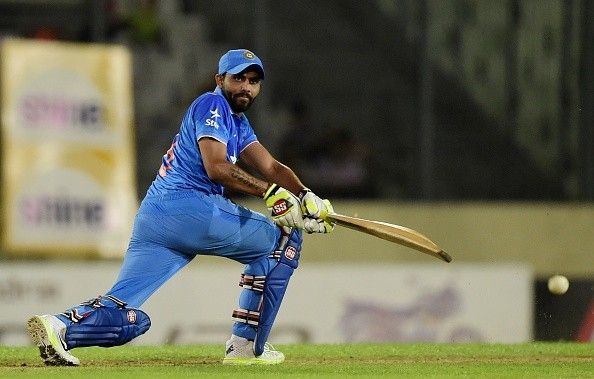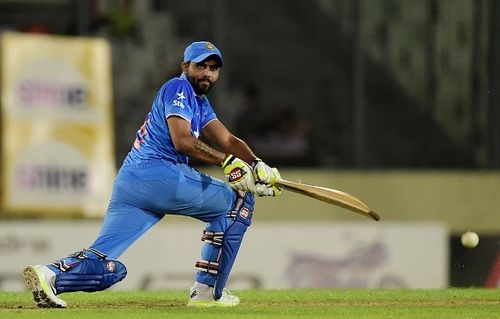
Despite all the criticism, is Ravindra Jadeja India's best No.7?

It was a warm October Jaipur evening in 1996 when Pankaj Dharmani walked in to bat at No.7 for India in a run chase of 250 against South Africa. With close to a hundred still to get, Dharmani had no time to poke around. A couple of delightful flicks down to the fine-leg got him to 8 and just when he was looking good for a memorable debut, Fanie de Villers flummoxed him with a slower off-cutter. Sadly, this was to be Dharmani’s only ODI stint despite an enviable first-class average of 50.
Mention the perils of batting lower down the order in ODI cricket and Dharmani could perhaps talk till the cows come back home. Succeed and you’re a hero, fail and you’re shunned to obscurity. While India has been bestowed with batting abundance – predominantly one that is top order heavy, it is lower down the order where the “men-in-blue” have been repeatedly found wanting. The famed Indian batting collapse is legendary. Mention it and collapses like the one that South Africa handed in the 2011 World Cup game comes to mind. But amidst the ruins of the Indian lower order batting line up, several stalwarts have stood their ground. Names such as the talismanic Kapil Dev and Ravi Shastri crop up on rummaging through the heap of batsmen that have featured for India in the lower middle-order. And for this very reason, I was both amused and flabbergasted when during a friendly banter, an enthusiastic Ravindra Jadeja fan suggested to me that despite all the recent criticism surrounding Jadeja, the “leftie” is actually the best that we have ever had at No.7.
Significance of lower-order batting
Let us for a moment take a close look at the significance of the No.7 batsman. The modern day game has evolved into one that is steeped in strategy with every member being assigned a role so specific that failure to execute it could not just contribute to defeat, but it could well mean that you are on the first flight back to first-class cricket. But just how vital a role – a cynic could argue - can a No.7 play in the context of an ODI? After all, when a side has had a good batting day, the No.7 comes in towards the fag end of the innings with just a handful of balls to play and when a “swing and a miss” hardly matters in the context of the game. And if the side has had a bad outing, the very sight of a No.7 striding out sooner than expected is bemoaned so lavishly by partisan followers that there is little relevance accorded to proceedings thereafter.
So why make a fuss over the Indian No.7 after all, I wondered for a fleeting moment. Thankfully, better sense prevailed owing to proven history. Remember the 2002 Natwest series final at Lord’s when India chased down an improbable 325? Mohammad Kaif scored a match winning 87 not out and yes, he batted at No.7. That is just one of several innings when Kaif repeatedly reminded us of how handy a batsman can be lower down the order.
In 2005 and at the peak of his powers, Kaif (with 26 innings at No.7) held the distinction of carrying the highest average (33.11) at that position in world ODI cricket. Sadly, despite Ravindra Jadeja’s numerous appearances at No.7, seldom has he produced magic that is even remotely akin to the one that Kaif produced at Lord’s.
No.7 can be a “high impact” spot
While not being technically adept for batting higher up the ODI order or for that matter cementing a Test match spot, Kaif possessed the “gully cricket” like ability to negotiate a tight spot and come out unscathed. He stole singles all over the in-field and when the fielders closed in, he resorted to chipping the ball over the covers and mid-on to run two’s and three’s. Also, for someone coming in at No.7, Kaif displayed remarkable temperament and stamina. This was made evident in a 2002 ICC Champions Trophy game against Zimbabwe played in the bitterly humid Premadasa Stadium. Coming into bat at 87/5, he scored an unbeaten 111 to help post 288. India would eventually win by 14 runs.
Such is the impact that a player can have when batting at No.7 and the U.P lad fit the part to perfection. Jadeja unfortunately, hasn’t quite set the role ablaze. There have been recent opportunities aplenty - at the World Cup and during the Bangladesh tour – for Jadeja to score the proverbial “big one” in a winning cause. Alas, the left-hander is yet to display anything remotely similar to what Kaif displayed with reasonable regularity.
India’s elite No.7’s
Despite India’s batting factory relentlessly producing gems through the sixties and seventies, the lower order continued to be brittle. Bowlers felt better when the likes of Gavaskar and Viswanath were back in the hut and the lower order was exposed. All this changed with Kapil Dev’s arrival. Possessed with dynamite like strength, he sent shivers down the spine of opposition bowlers. Across three World Cups from 1983 to 1992, the “Haryana Hurricane” batted six times at No.7 while lending weight to India’s lower order batting. And as if taking a cue from Kapil’s superhuman like abilities, India has employed 20 different batsmen at No.7 in all World Cups from 1983 to 2015. While Kapil himself and Ravi Shastri shouldered the responsibility in the eighties, it was Nayan Mongia and Ajay Jadeja in the nineties. In the decade thereafter Kaif and Dinesh Mongia played the part and in recent times, the No.7 mantle has passed on to Yusuf Pathan, Suresh Raina and Ravindra Jadeja.
One aspect, however, stands out prominently in the pack - they were all either highly proficient batsmen or telling all-rounders capable of making an impactful contribution in multiple disciplines. In comparison, Ravindra Jadeja appears to be stuck in the learning curve limbo.
A closer look at the records of the aforementioned that featured prominently at No.7 since 1978 reveals precious more.
The top 10 batsmen with the most career runs to have featured at No.7
| # | Player | Span | Mat | Ave | 100 | 50 |
| 1 | Ajay Jadeja | 1992-2000 | 196 | 37.47 | 6 | 30 |
| 2 | Ravindra Jadeja | 2009-2015 | 121 | 32.21 | 0 | 10 |
| 3 | M Kaif | 2002-2006 | 125 | 32.01 | 2 | 17 |
| 4 | Ravi Shastri | 1981-1992 | 150 | 29.04 | 4 | 18 |
| 5 | Dinesh Mongia | 2001-2007 | 57 | 27.95 | 1 | 4 |
| 6 | Yusuf Pathan | 2008-2012 | 57 | 27 | 2 | 3 |
| 7 | Manjo Prabhakar | 1984-1996 | 130 | 24.12 | 2 | 11 |
| 8 | Kapil Dev | 1978-1994 | 225 | 23.79 | 1 | 14 |
| 9 | Nayan Mongia | 1994-2000 | 140 | 20.19 | 0 | 2 |
| 10 | Roger Binny | 1980-1987 | 72 | 16.12 | 0 | 1 |
Table #1: Ranking by career averages
| # | Player | Span | Mat | SR | Runs |
| 1 | Yusuf Pathan | 2008-2012 | 57 | 113.6 | 810 |
| 2 | Kapil Dev | 1978-1994 | 225 | 95.07 | 3783 |
| 3 | Ravindra Jadeja | 2009-2015 | 121 | 84.45 | 1804 |
| 4 | M Kaif | 2002-2006 | 125 | 72.03 | 2753 |
| 5 | Dinesh Mongia | 2001-2007 | 57 | 71.47 | 1230 |
| 6 | Ajay Jadeja | 1992-2000 | 196 | 69.8 | 5359 |
| 7 | Nayan Mongia | 1994-2000 | 140 | 68.9 | 1272 |
| 8 | Ravi Shastri | 1981-1992 | 150 | 61.07 | 3108 |
| 9 | Manoj Prabhakar | 1984-1996 | 130 | 60.26 | 1858 |
| 10 | Roger Binny | 1980-1987 | 72 | 60.13 | 629 |
Table #2: Ranking by strike rate
That Ravi Shastri sits behind the moustache twirling maverick in career averages seems almost preposterous. Shastri played 150 ODIs and despite a presumption of Jadeja eventually playing as many games, it’s hard to imagine him scoring as many hundreds as the Mumbaikar did – even if he were to open the batting. Batting fineness and match winning abilities notwithstanding, Shastri brought a steely resolve forth. In comparison, Jadeja’s recent dismissals in Bangladesh were akin to a kid in the park being unable to fend off the marauding bullies.
So clearly, despite the popular notion of Ravindra Jadeja being labelled outstanding at No.7, I am convinced that it is nothing more than a popular misconception. That said, there is no denying that the 26-year-old from Saurashtra possesses abilities in abundance. What truly matters, however, is performances on the ground and telling displays with the willow. Unless that occurs repeatedly, Jadeja will continue to stay a far from the mythical crown of “India’s best No.7”.